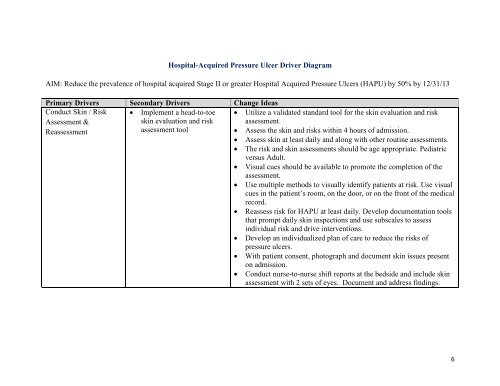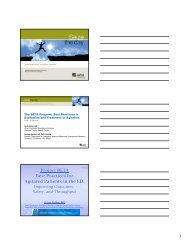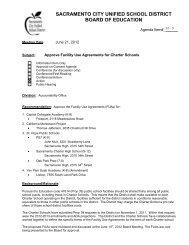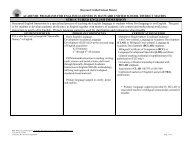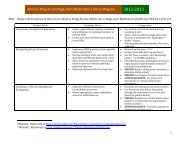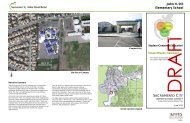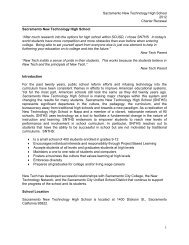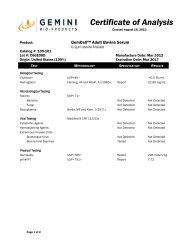Hospital-Acquired Pressure Ulcer Driver Diagram AIM: Reduce the ...
Hospital-Acquired Pressure Ulcer Driver Diagram AIM: Reduce the ...
Hospital-Acquired Pressure Ulcer Driver Diagram AIM: Reduce the ...
Create successful ePaper yourself
Turn your PDF publications into a flip-book with our unique Google optimized e-Paper software.
<strong>Hospital</strong>-<strong>Acquired</strong> <strong>Pressure</strong> <strong>Ulcer</strong> <strong>Driver</strong> <strong>Diagram</strong><br />
<strong>AIM</strong>: <strong>Reduce</strong> <strong>the</strong> prevalence of hospital acquired Stage II or greater <strong>Hospital</strong> <strong>Acquired</strong> <strong>Pressure</strong> <strong>Ulcer</strong>s (HAPU) by 50% by 12/31/13<br />
Primary <strong>Driver</strong>s Secondary <strong>Driver</strong>s Change Ideas<br />
Conduct Skin / Risk<br />
Assessment &<br />
• Implement a head-to-toe<br />
skin evaluation and risk<br />
• Utilize a validated standard tool for <strong>the</strong> skin evaluation and risk<br />
assessment.<br />
Reassessment<br />
assessment tool<br />
• Assess <strong>the</strong> skin and risks within 4 hours of admission.<br />
• Assess skin at least daily and along with o<strong>the</strong>r routine assessments.<br />
• The risk and skin assessments should be age appropriate. Pediatric<br />
versus Adult.<br />
• Visual cues should be available to promote <strong>the</strong> completion of <strong>the</strong><br />
assessment.<br />
• Use multiple methods to visually identify patients at risk. Use visual<br />
cues in <strong>the</strong> patient’s room, on <strong>the</strong> door, or on <strong>the</strong> front of <strong>the</strong> medical<br />
record.<br />
• Reassess risk for HAPU at least daily. Develop documentation tools<br />
that prompt daily skin inspections and use subscales to assess<br />
individual risk and drive interventions.<br />
• Develop an individualized plan of care to reduce <strong>the</strong> risks of<br />
pressure ulcers.<br />
• With patient consent, photograph and document skin issues present<br />
on admission.<br />
• Conduct nurse-to-nurse shift reports at <strong>the</strong> bedside and include skin<br />
assessment with 2 sets of eyes. Document and address findings.<br />
6
Manage Moisture • Avoid skin wetness; protect<br />
and moisturize as needed.<br />
• Use topical agents that hydrate <strong>the</strong> skin and form a moisture barrier<br />
to reduce skin damage. Consider using all-in-one cleaning/moisturebarrier<br />
clo<strong>the</strong>s.<br />
• Set specific timeframes or create reminder systems to reposition;<br />
frequently offer toileting, PO fluids, and reassess for wet skin.<br />
Remember <strong>the</strong> 3 P’s – Pain/Potty/Position-<strong>Pressure</strong>.<br />
• Involve licensed and unlicensed staff such as nurses aides in every<br />
hour rounding and checking for <strong>the</strong> 3 P’s.<br />
• Consider a Stage I pressure ulcer as a “warning sign”.<br />
• Use under-pads that provide a quick-drying surface and wick<br />
moisture away from skin.Keep supplies readily available at <strong>the</strong><br />
bedside in case <strong>the</strong> patient is incontinent.<br />
• Develop a skin-care cart with supplies and a guide for how to<br />
manage skin issues according to severity.<br />
• Combine interventions with o<strong>the</strong>r routine activities.<br />
• Identify a staff nurse for each unit to serve as a skin care resource.<br />
• Avoid using a thick paste as a cleansing/moisture barrier (staff may<br />
have difficulty cleaning <strong>the</strong> paste when stool is present and may<br />
injure <strong>the</strong> skin).<br />
7
Primary <strong>Driver</strong>s Secondary <strong>Driver</strong>s Change Ideas<br />
Optimize<br />
Hydration and<br />
• Monitor weight, nutrition<br />
and hydration status<br />
• Give patients <strong>the</strong>ir food/liquid preferences to enhance hydration and<br />
nutrition.<br />
Nutrition<br />
• Provide nutritional supplementation if needed and not contraindicated.<br />
• Generate an automatic Registered Dietician consult if <strong>the</strong> patient is at high<br />
risk.<br />
• Monitor weight, food and fluid intake, and laboratory test results.<br />
• Provide at-risk patients with a water container of a unique color so staff and<br />
families will know to encourage hydration.<br />
• Assist <strong>the</strong> patient with meals if needed and encourage snacks.<br />
• Offer water to <strong>the</strong> patient when rounding for <strong>the</strong> 3 “P’s”.<br />
Pain/Potty/Position<br />
8
Minimize<br />
<strong>Pressure</strong>, Shear &<br />
Friction<br />
• Turn and reposition patients<br />
at least every two hours.<br />
• Develop and institute early<br />
mobility/ambulation<br />
protocols<br />
• Use visual or musical cues, e.g. a turning clock, bells, and alarms, at <strong>the</strong><br />
nurse’s station as a reminder to turn and reposition <strong>the</strong> patient.<br />
• Use visual cues at <strong>the</strong> bedside to remember turn <strong>the</strong> patient, e.g. a turning<br />
clock or whiteboard that displays <strong>the</strong> time for <strong>the</strong> next turn.<br />
• Establish ‘rules’ for which side patients should lie on at certain times (e.g.<br />
even hours on right side, odd hours on left side).<br />
• Ensure pressure-reducing equipment is available at all times. (E.g. Beds,<br />
mattresses, and foam wedges, etc.).Use a device that elevates <strong>the</strong> heel and<br />
prevents external rotation of <strong>the</strong> ankle and foot.<br />
• Use special beds, mattresses, foam wedges, and use pillows (only for limbs)<br />
to redistribute pressure.<br />
• Operating room tables should be covered by special overlay mattresses.<br />
• Use breathable glide sheets and or lifting devices to prevent shear and<br />
friction.<br />
• Use ceiling lifts to encourage mobility and movement and to prevent staff<br />
work-related injuries.<br />
Limit layers of linen to no more than 3 (using more than 4 layers has been<br />
shown to be an independent risk factor for HAPU). A breathable glide sheet<br />
that is helpful for in-bed mobility and lifts are best for out-of-bed mobility.<br />
9


